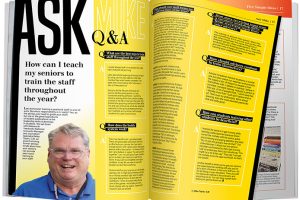Posted Deadlines – Keep Staff on Track
I suffered from deadline dread my first year as adviser of The Spinnaker at Laney High School. Despite those early days when pages were turned in the day of shipping for the mad dash to the plant, I have survived and learned from my mistakes. While I still have a lot to learn about yearbook publishing, I have come to understand that deadlines are a necessary evil.
First, I believe in being upfront and at times blunt for the purposes of producing a product that will be remembered for years to come; therefore, I believe my staff needs to know and work from a posted deadline schedule. This deadline schedule includes plant deadlines, shipping deadlines and mini deadlines.
Once deadlines are set by Walsworth, I post them on a large calendar in the production area of the room. This production area is simply a bulletin board that includes the ladder, deadlines and ideas for pages. The posted deadlines are the real dates set by Walsworth, not dates fabricated to ensure pages reach the plant on time.
To ensure that we make our plant deadlines, the editorial staff sets shipping deadlines that guarantee pages will arrive at the plant before assigned deadlines. These shipping deadlines are typically a week before plant deadlines. This provides enough time for final editorial reviews of pages.
Second, I believe in the divide-and-conquer theory, separating the different aspects of spreads into mini-deadlines in order to achieve the big result. Once the ladder is complete, I compose a production schedule that includes all aforementioned deadlines with mini deadlines intertwined to promote smooth sailing. These mini deadlines are broken into small and big.
Small mini deadlines generally include photos, captions, copy, and complete first drafts of spreads. Dividing these tasks into separate deadlines helps students with organization and mental attitude. They accomplish a spread in pieces rather than tackling the entire thing at once.
These varying deadlines are typically spread over a month, allowing for revisions or retakes if necessary. The editorial staff meets with the entire class every Friday to recap the week’s events and see if spreads are moving according to plan. This also ensures that students are working on small deadlines in order to achieve success.
Big mini deadlines include final drafts of spreads that in the eyes of the students are shipment-ready. These due dates vary with the topic of the spread. By the time pages reach this point, the different components of the spread have been edited and revised at least three times. The idea is to reduce the amount of last-minute changes before shipping. I try not to have more than two final spreads due on the same day.
Despite the deadline-after-deadline approach in the class, celebrations occur at every corner of production and as plant deadlines are met. This system has worked for me even during my five-week maternity leave this past year, when my students met our deadlines and succeeded in producing their yearbook
Tag:Staff Management



